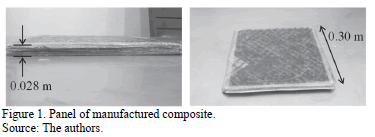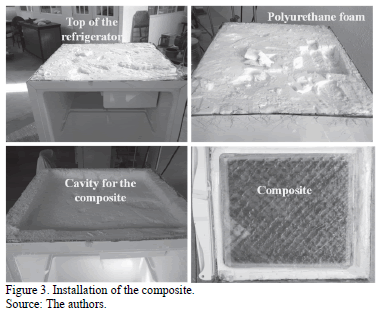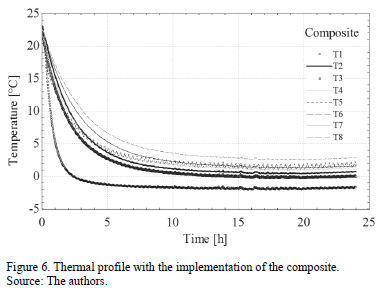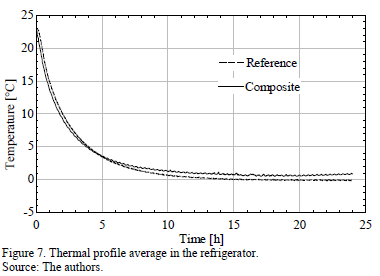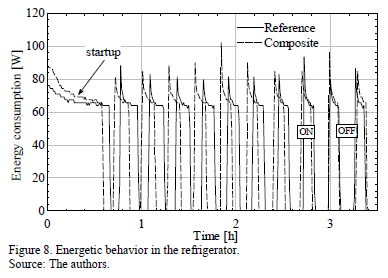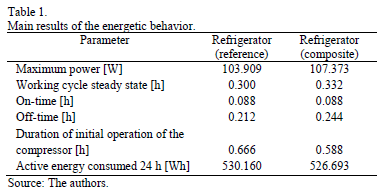
Publicado
Thermal and energy evaluation of a novel polymer-ceramic composite as insulation for a household refrigerator
DOI:
https://doi.org/10.15446/dyna.v82n193.45988Palabras clave:
household refrigerator, composite, energy consumption, pyro-expanded perlite (es)Descargas
DOI: https://doi.org/10.15446/dyna.v82n193.45988
Thermal and energy evaluation of a novel polymer-ceramic composite as insulation for a household refrigerator
Evaluación térmica y energética de un nuevo composite polímero-cerámico como aislante en un refrigerador doméstico
Juan Manuel Belman-Flores, Bárbara González-Rolón, Juan Serrano-Arellano & Sergio Gámez-Arredondo
Department of Mechanical Engineering, Engineering Division, Campus Irapuato-Salamanca, Universidad de Guanajuato, Salamanca, Gto. Mexico jfbelman@ugto.mx, barbara@ugto.mx, johnnsear@hotmail.com, sa.gamez@hotmail.com
Received: October 4rd, 2014. Received in revised form: April 9th, 2015. Accepted: April 23th, 2015
This work is licensed under a Creative Commons Attribution-NonCommercial-NoDerivatives 4.0 International License.

Abstract
This article presents a feasibility study of a new polymer-ceramic
composite material applied as a thermal insulator on the surface of a low net
volume household refrigerator. This paper describes its manufacture in a
succinct manner, and a thermal and energy comparison between the factory
refrigerator and the refrigerator with the composite installed. Based on the experiments,
it is concluded that when using the composite, the average internal temperature
of the fridge is increased by 1°C, for practical and design purposes, the
refrigerator still functions below 3°C. It was also found that at stable
operating conditions the energy consumption using the composite saves
approximately 1.5%. Despite these slight savings, the
pyro-expanded perlite composite acts as a thermal isolating material. This
material may exhibit better ease of use and thermal, energetic and economic
benefits, without omitting the environmental characteristics that they favor.
Keywords: household refrigerator; composite; energy consumption; pyro-expanded perlite.
Resumen
Este
artículo presenta un estudio de viabilidad de un nuevo material compuesto
polímero-cerámico aplicado como aislante térmico sobre una superficie de un
refrigerador doméstico de pequeña capacidad volumétrica. Este trabajo describe
de manera sucinta su manufactura así como la comparación energética y térmica
entre el refrigerador de referencia (cuando sale de fábrica) y el refrigerador
con el composite instalado. Experimentalmente, cuando se usa el composite la
temperatura interna promedio del frigobar incrementa alrededor de 1°C, que para
propósitos prácticos y de diseño, el refrigerador aún funciona por debajo de
los 3°C. Además, para condiciones de operación estables, la energía consumida
usando el composite ahorra aproximadamente 1.5% en comparación con el refrigerador
de referencia. A pesar de este ligero ahorro, la perlita pyro-expandida actúa
como material aislante. Este material puede exhibir mejor facilidad de uso y
beneficios térmicos, energéticos y económicos, sin omitir las características
ambientales a su favor.
Palabras clave: refrigerador doméstico; composite; consumo de energía; perlita pyro-expandida.
1. Introduction
Presently, companies involved in the production of household appliances face heavy regulations related to energy consumption, emissions of greenhouse gases and environmental impact, among others. Refrigerators are among the most manufactured devices because their use is essential in homes. Refrigerators based on vapor compression are major energy consumers, and its incidence is increasing in less developed countries. The annual production of refrigerators worldwide in 2009 was approximately 80 million units, which is increasing rapidly [1]. For instance, in Mexico 80% of the housing owns at least one refrigerator, this counts for more than 23 million domestic refrigerators working [2]. In order to evaluate instantaneous domestic power consumptions, a house simulator has been developed [3], in which the household refrigerator is considered an appliance of medium priority with high energy consumption. In addition, the electric power consumed by a household refrigerator is considered to be very costly, a reduction in the electricity consumption of a refrigerator could generate not only a competitive advantage for the manufacturer, but also in terms of the savings in overall energy use and a reduction of the total environmental impact of the product. Several alternatives to improve the thermal-energy behavior found in refrigerators have been reported in the scientific literature [4]. The most common approaches to reduce the energy consumption of household refrigerators to date include the use of optimized insulation [5], energy efficient compressors and enhanced heat transfer in heat exchangers [6].
In the area of thermal insulation, studies that incorporate vacuum insulating panels in expansion foaming have been carried out [7] and also studies on geo-polymerized perlite foams [8]. It is well known that blowing agents are most widely used in domestic refrigeration [9]. The rigid polyurethane as thermal insulation was being developed but manufacturers first abandoned the use of R11 (CFC) as blowing agent, to make way for R141b (HCFC) and the next generation R245fa (HFC) and cyclopentane (HC). However, the use of these blowing agents still has drawbacks, both environmental and energy, and initial investment in changing production lines, as well as the lack of a safe operation for the case of the cyclopentane. Recently, a new molecule, Forane1233zd was announced as blowing agent and of low global warming potential (GWP) by the company Arkema [10]. Evaluations by the company cast that this new blowing agent provides better energy performance compared with conventional agents. Thermal insulation is very important in the cold generation industry, which is looking for new and better materials for use as insulation, among which are compounds or composites.
The aim of this paper is to present the simple application of a novel polymer-ceramic composite as thermal insulation in a household refrigerator of small capacity. For this purpose, the feasibility of the composite is evaluated in an experimental facility from both the thermal and energetic points of view. It is concluded that the composite acts as insulation under the experimental conditions and development of this material. Thus it enables a promising proposal in the field of refrigeration.
2. Polymer-ceramic composite
Composite materials are not a human invention, many materials found in nature are composites, and wood is a typical example of what is constituted by cellulose fibers wrapped in a matrix of natural resins. The fibers provide the resistance needed, in some directions, to the plant. A composite material is a combination of two or more different materials that do not chemically react. The materials that constitute it maintain their properties in the composite, even though the combination produces more than the sum of its parts. One of the materials that constitute the composite is in the continuous phase and is called the matrix. The other principal constituent is a backbone in the form of fibers or particles that, in general, are added to the matrix in order to improve its properties. The backbone forms a discontinuous phase that is uniformly dispersed across the matrix.
Currently, composite materials have been put to use in diverse applications, due to the ease of processing, good mechanical and thermal properties, favorable environmental aspects and, savings in production costs, besides presenting an alternative for energy saving [11-13]. The field of application of composite materials is wide, for example, for engineering applications at low temperatures there has been interest in using poly-ceramic composites. Not only because it provides a good isolation from heat and sound, but also because it is environmentally clean in its production and its application [14].
In this way, this paper presents the thermal and energetic accountability of a composite material developed in the Materials Lab of the Engineering Division of the University of Guanajuato, Mexico, as an alternative thermal isolation element in refrigeration systems [15].
2.1. Manufacturing the composite
The composite is made of perlite fibers in the shape of strands supported in a matrix of thermo-stable resin, which consists of diglycidyl ether of bisphenol-A (DGEBA) and diethylentriamine (DETA). The composite material was manufactured for the purpose of evaluating its application as a thermal insulator in household refrigeration. The method and process involved in manufacturing the composite is based on the work of a master's thesis developed in the Materials Laboratory of the Engineering Division in the University of Guanajuato [16].
2.1.1. Preparation for the perlite pyro-expanded
The pyro-expanded perlite is named like this because it is a mineral with water trapped in its structure, by subjecting it to higher temperatures the water vaporizes, which causes the material to expand and thereby reduce its density without affecting its thermal conductivity. As such, it is used to make inorganic foam materials for thermal isolation due to its excellent thermo-physical properties; additionally it is inflammable and is therefore safe for human use, as well as in the environment. Commercially, the normal temperature range that this isolating material can withstand ranges from 1 K to 1033 K.
Pyro-expanded perlite is used as a primer material for the synthesis of the composite, this is due to the idea of fabricating an isolating material with a density apparently similar to conventional insulators applied to household refrigeration. This is not possible using non-expanded perlite as its density is approximately 1100 kg/m3, whilst the density of pyro-expanded perlite is between 30 and 150 kg/m3 [8]. The preparation of the fibers is the most important part of the fabrication of the composite as its physical, mechanical and thermal properties are strongly determined by the backbone fibers.
The initial material of pyro-expanded perlite presents itself in the shape of small amorphous rocks, which are ground and sieved until it reaches a fine consistency, similar to 150 mm talc. The fibres are made using this powder through thermal treatment in mullite moulds, which have good mechanical resistance, low density, inflammable, exhibit dimensional stability and are also good thermal and electrical isolators. The fibres formed through this process have different lengths due to the limited controls on manufacture. Epoxy resins are used in a great number of cryogenic applications due to their resistance to low temperatures and they give the composite excellent mechanical properties. The epoxy resin used as a matrix in the composite was prepared following instructions from the manufacturer. The epoxy (ID 4D114) and the hardener (ID NC566) were obtained from the EPOXEMEX Company. After obtaining the fibers and having prepared the matrix, we progressed to the formation of the panel of the composite through a geometric arrangement of the fibers embedded in the matrix, whose final structure is shown in Fig. 1.
Among the advantages offered by this material, and based upon its particular application in this research, it is its low thermal conductivity of about 0.025 W/m K. Besides, the composite material has a good mechanical resistance and tenacity at low temperatures. More information on the properties and the manufacture of the composite may be found in [15]. As such, it is of great importance to highlight the environmentally favorable aspects of the composite as compared to conventional thermal insulating foams, the composite does not use hydrocarbons, clorofluorocarbons, hydrofluorocarbons nor hidrochlorofluorocarbons; but it uses a naturally occurring mineral, pyro-expanded perlite. This means that its manufacture avoids large emissions of pollutants that cause global warming or wastage of the ozone layer.
3. Experimental refrigerator
Experimental tests were performed for a commercial minibar (see Fig. 2) with a net capacity of 0.046 m3 (1.6 ft3). The external dimensions of the experimental refrigerator are 0.44 m x 0.5 m x 0.47 m (width x depth x height) and the wall thickness is approximately 0.037 m of polyurethane with a mixture of R141b/R22 as blowing agent, its thermal conductivity is between a range of 0.0175 a 0.024 W/m K. A refrigerator with a small storage capacity was chosen for practical reasons as less composite needs to be produced in order to replace the original insulation.
The experimental refrigerator has one compartment divided by a wire shelf, the door also has shelves protected by wire and there is also an exposed evaporator type roll bond, which works by natural convection and comprises the area of a small freezer. The minibar is based on compression vapor technology.
3.1. Installation of the composite
In order to evaluate the composite developed, we installed the material at the top of the refrigerator. This location was chosen in order to replace the conventional insulation the purpose of which is to avoid damaging the hot pipelines that pass through the lateral walls of this kind of refrigerator. In addition, the placement of the panel was analyzed according to the location of the evaporator; a zone where the lower temperatures are present and it may be the area of higher energy transfer within the enclosed environment. Fig. 3 shows the implementation of the panel composite.
In order to adequately align the panel, several holes were partially filled with conventional foam in order to exert pressure whilst installing the top sheet of the refrigerator.
3.2. Instrumentation and measurements
The refrigerator under study has attached sensors in order to measure parameters such as temperature and energy consumption. The tests were carried out at position 4 of the temperature dial, which are the refrigerator factory settings. The temperature sensors are calibrated in our laboratory using certified references, obtaining an uncertainty of ±0.3 K, while the energy consumption is measured using an energy analyzer fluke with a certified accuracy within ± 0.7 %. In order to measure the temperature in the compartment, seven thermocouples were placed inside containers of 0.245 l (0.000245 m3) with a mixture at 50% in volume of water and glycol. The containers were distributed on the wire shelf and the door shelves (see Fig. 2). The temperature measurement in the freezer was obtained with one thermocouple placed inside a wood block in order to avoid density and volume changes during the test.
Several tests were performed within approximately 24 hours, including the transitory performance during the startup and halt of the compressor. The refrigerator operated at a room temperature of 295 K ± 1 K and with a relative humidity of 70 ± 5%. The signals generated by the temperature measurement device were stored in a data acquisition system based on a PC with LabVIEW SignalExpress® software. The energy analyzer is configured for data storage in a lapse of 24 hours each 40 seconds, and both temperature and energy measurements are taken in parallel form.
4. Experimental results
The experimental analysis involves comparing the thermal and energy conditions of the minibar in its reference state (using refrigerator Factory settings) and with the modification (implementation of composite). The refrigerator in both tests is evaluated with the door shut and without load, i.e. empty, only with thermocouples inside for measurements. The tests are started at approximately the same external conditions of temperature and humidity. For this, tests were performed for a duration of approximately 24 hours in both cases. Fig. 4 shows the experimental test bench.
4.1. Thermal analysis
In Figs. 5 and 6, the thermal profile of the reference refrigerator and the refrigerator with the composite implementation are show respectively. Fig. 5 clearly shows that the lower temperature corresponds to the small freezer compartment. It is reasonable that the stability in this region is reached in less time, whereas practically all of the measurements are above 0°C. Also, it may be noted that the steady thermal behavior of this refrigerator of low capacity begins within approximately 10 hours of starting the test.
Regarding the thermal behavior using the composite material, Fig. 6 shows the thermal profile. Entrance similarity is observed in the temperature trends, it is observed that the measurement of some points shows slight increases in the temperature of the refrigerator using the composite. The most notable case is the thermocouple located in the freezer. The slight thermal variations present in the refrigerator using the composite are due simply to the structure of the material affecting the behavior of the energy transfer by natural convection in the cooling compartment.
A lack of thermal cycles is also observed in both thermal performances (Fig. 5 and 6). First, this may be due to the type of calibration of the unit in relation to the times of startup and halt of the compressor, all of this taking into account that the refrigerator was evaluated with the door shut; second, because of the size of the refrigerator, which represents a much smaller space and little disturbance by external conditions. Here is highlighted the proper application of the composite which causes a similar thermal behavior in respect to the reference refrigerator. Continuing with the thermal comparison, in Fig. 7 the average temperature profile is compared between the reference refrigerator and the one with the composite.
Analyzing the range of stabilization, it may be concluded that a difference of 1°C exists between the unit working with the composite and the unit with the conventional insulator. Upon evaluation of the practical application of the composite as a thermal isolator, we may say that it takes an acceptable temperature within the factory settings at position 4 (around 3°C).
According to the thermal profiles, it is possible to establish that during the experimental use of the composite, the internal temperature of the equipment is slightly above the reference state. However, it is possible to maintain a stable thermal profile that guarantees the correct functioning of the refrigerator. With the application of the composite it is concluded that the refrigerator is functioning within an adequate thermal range, which leads us to presume that this material may be put to good use in this kind of system.
4.2. Energy analysis
This section compares the energy consumption of both kinds of refrigerator. Fig. 8 shows the initial operation cycles, whose behavior is constant in the successive cycles during the 24 hour test time. It was observed that the first functioning cycle (start-up) lasts longer; this is due to the initial temperature difference between the refrigerator and its environment.
For this reason, the form of the figure has a larger start-up cycle for the reference refrigerator, which is due to the test starting at a slightly higher temperature, which is why the compressor works harder in order to reach a certain calibration temperature. Additionally, in the figure, it may be observed that for the previous functioning cycles the operation time (with the compressor turned on) is similar for both functioning cases.
The most interesting energetic behavior results are indicated in Table 1. For the comparison between the two functioning states, the operating difference radiates in the time it takes to turn off the compressor, which presented a difference of 0.032 hours. When the insulating composite is installed in the refrigerator, the compressor operates for 0.088 hours and rests for a total of 0.244 hours, meaning that a complete cycle occurs in 0.332 hours.
Once the characteristic functioning times have been analyzed, it is determined that the reference refrigerator under stable functioning conditions has a higher number of operating cycles during a set period. For example, from the analysis of the energy consumption in the last four hours of operation of each one of the tests, it may be concluded that the refrigerator with the composite saves approximately 1.5% more energy than the reference refrigerator. This is a good indication that, at least, the composite as insulation has adequate energy performance; all of this under the test conditions performed in our laboratory. The authors consider that more significant energy savings can be achieved through the improvement in the development of the material. Moreover, this energy comparative represents the composite application in one of the most critical parts of the minibar because of the closeness to the evaporator and what it represents in terms of the temperature difference in this space and its surroundings.
It should be highlighted that the composite developed has been exposed to high service requirements against conventional cellular foam, which is the most common insulator used in household refrigerators. Also, the composite adheres to the imperfections generated during the (experimental) manufacturing process, such as: the quantity of material used, uniformity of the fiber, porosity of the material, adherence between layers, etc. as well as adequately fixing the material to the appropriate space. Despite all this, the pyro-expanded composite complies as a thermal isolating material.
On the other hand, one of the possible doubts generated in the development of the material, is its manufacture. According to the development of the material presented in this work, it seems that it was a pretty lengthy and costly process. However, it should not be forgotten that this process was planned and developed only at the laboratory level, using small specimens and molds, additionally; a limiting factor was the manufacturing capacity of the pyro-expanded perlite fibers. We consider that the same process, but at an industrial or mass scale level may exhibit greater ease, and thermal, energetic and economic benefits, without omitting the environmentally favorable characteristics. Within the parameters that must be taken into account to improve the composite and to present better thermal and energy performances are: the shape, size, distribution, quantity, material type and its particular properties in the dispersed phase, which in this case is ceramic. Moreover, the matrix is providing, in its chemical composition, properties that are the most homogeneous as possible and in the amounts presented in this composite. In the case of this work and in the traditional way, other geometry could be tested for the stacking of the disperse phase.
5. Conclusions
This article briefly presented the development in the lab and the principle characteristics of a new composite material, proposed as a thermal insulator. The emphasis of the study consisted in the evaluation of the feasibility of the new material implemented in the upper wall of a refrigerator with a small capacity (minibar). The research focused on a comparison of the thermal and energy performance of the fridge at factory settings and the fridge with the composite installed. It is concluded that the refrigerator with the composite exhibits an average increase of 1°C as compared to the reference refrigerator (using factory settings). On the energy side and for a stable period in the last four operation hours of the refrigerator, it was found that the refrigerator with the implemented composite saves approximately 1.5% more energy than the reference refrigerator with its factory settings.
More generally, the new material proposed in this paper as an insulator may be an interesting alternative that has room for improvement. Although the composite was made by hand in this case, it presented acceptable results, making it an option in the field of domestic refrigeration.
Acknowledgments
The authors wish to thank the Directorate for Research Support and Postgraduate Programs at the University of Guanajuato for their support in the translation and editing of the English-language version of this article
References
[1] Seong, S.J. and Soo, H.J., Experimental study of heat transfer characteristics for a refrigerator by using reverse heat loss method. International Communications in Heat and Mass Transfer, 38 (5), pp. 572-576, 2011. DOI: 10.1016/J.Icheatmasstransfer.2011.02.007
[2] Centro Nacional de Población y Vivienda, Instituto Nacional de Estadística y Geografía (INEGI), México, 2010.
[3] Miceli, R., Energy management and smart grids. Energies, 6 (4), pp. 2262-2290, 2013. DOI: 10.3390/en6042262
[4] Bansal, P., Vineyard, E. and Abdelaziz, O., Advances in household appliances - A review. Applied Thermal Engineering, 31 (17-18), pp. 3748-3760, 2011. DOI: 10.1016/J.Applthermaleng.2011.07.023
[5] Yoon, W.J., Seo, K. and Kim, Y., Development of an optimization strategy for insulation thickness of a domestic refrigerator-freezer. International Journal of Refrigeration, 36 (3), pp. 1162-1172, 2013. DOI: 10.1016/J.Ijrefrig.2012.11.013
[6] Marques, A.C., Davies, G.F., Evans, J.A., Maidment, G.G. and Wood, I.D., Theoretical modelling and experimental investigation of a thermal energy storage refrigerator. Energy, 55 (15), pp. 457-465, 2013. DOI: 10.1016/j.energy.2013.03.091
[7] Koebel, M., Rigacci, A. and Achard, P., Aerogel-based thermal superinsulation: An overview. Journal of Sol-Gel Science and Technology, 63, pp. 315-339, 2012. DOI: 10.1007/s10971-012-2792-9
[8] Vaou, V. and Panias, D., Thermal insulating foamy geopolymers from perlite. Minerals Engineering, 23 (14), pp. 1146-1151, 2010. DOI: 10.1016/j.mineng.2010.07.015
[9] Johnson, R.W., The effect of blowing agent choice on energy use and global warming impact of a refrigerator. International Journal of Refrigeration, 27 (7), pp. 794-799, 2004. DOI: 10.1016/j.ijrefrig.2004.07.005
[10] Arkema reveals new low-GWP blowing agent for polyurethane foams. Additives for Polymers, 2013 (11), pp. 3-3, 2013. DOI: 10.1016/S0306-3747(13)70169-6
[11] Yamsaengsung, W. and Sombatsompop, N., Effect of chemical blowing agent on cell structure and mechanical properties of EPDM foam, and peel strength and thermal conductivity of wood/NR composite-EPDM foam laminates. Composites Part B: Engineering, 40 (7), pp. 594-600, 2009. DOI: 10.1016/j.compositesb.2009.04.003
[12] Rios-Soberanis, C.R., Cruz-Estrada, R.H., Rodríguez-Laviada, J. and Pérez-Pacheco, E., Study of mechanical behavior of textil reiforced composite materials. DYNA, 79 (176), pp. 115-123, 2012.
[13] Gutiérrez, J., Cadena, C. and Bula, A., Thermal insulation produced from rice husk agglomerated using starch produced by saccharomyces cerevisiae. DYNA, 81 (184), pp. 138-143. 2014.
[14] Mallick, P.K., Composites Engineering Handbook, in Composites Engineering Handbook (Materials Engineering Series). New York: Marcel Dekker, Inc., 1997.
[15] Gámez-Arredondo, S.A., Application of polimer/ceramic composite for improvement thermal and energetic of a domestic refrigerator, MSc. Thesis, Department of Mechanical Engineering, University of Guanajuato, México, 2013.
[16] Enríquez-Gutiérrez, V.M., Design of a composite of perlite piro-expanded/epoxy for thermal insulation in cryogenic process, MSc. Thesis, Department of Mechanical Engineering, University of Guanajuato, México, 2011.
J.M. Belman-Flores, obtained the PhD degree from University Jaume I, Spain in 2008. He is currently a full-time professor in the engineering division at the University of Guanajuato, Mexico. Over 70 papers have been published in National and International Congress/Journals. His research interests includes: refrigeration, thermal systems, energy saving and modeling systems.
B. González-Rolón, received Dra. in Science of Materials from UNAM, Mexico in 1997. She is a full-time professor in the materials science in the Department of Mechanical Engineering, at University of Guanajuato, Mexico. Teaching: 228 Graduate courses, 20 Master's courses, 9 Doctoral courses. Supervised theses: 18 Graduate, 8 Master's degrees, and 2 Doctoral degrees. Theses currently being supervised: 3 Graduate degrees, 3 Master's degrees, and 2 doctoral degrees. Keynote speech at Mejico University in Nagoya, Japan, entitled "Present status of insulating materials in Mexico". September 2000, Nagoya, Japan.
J. Serrano-Arellano, received his Dr. degree in Mechanical Engineering in 2013 in the National Center for Research and Technological Development (CENIDET). Currently he is performing postdoctoral studies at the University of Guanajuato, Mexico. His areas of interest are heat transfer, mass transfer, ventilation systems, and renewable energy among others.
S. Gámez-Arredondo, received his MSc. degree in Mechanical Engineering in 2013 in the University of Guanajuato, Mexico. Currently he is working at the InverCost Group, Mexico. His areas of interest are thermal and power systems.
Cómo citar
IEEE
ACM
ACS
APA
ABNT
Chicago
Harvard
MLA
Turabian
Vancouver
Descargar cita
CrossRef Cited-by
1. D.A. Rodríguez-Valderrama, J.M. Belman-Flores, D. Hernández-Fusilier, D.M. Pardo-Cely, M.A. Gómez-Martínez, S. Méndez-Díaz. (2023). Implementation of fuzzy control in a domestic refrigerator considering the influence of the thermal load. International Journal of Refrigeration, 149, p.23. https://doi.org/10.1016/j.ijrefrig.2022.12.018.
Dimensions
PlumX
Visitas a la página del resumen del artículo
Descargas
Licencia
Derechos de autor 2015 DYNA

Esta obra está bajo una licencia internacional Creative Commons Atribución-NoComercial-SinDerivadas 4.0.
El autor o autores de un artículo aceptado para publicación en cualquiera de las revistas editadas por la facultad de Minas cederán la totalidad de los derechos patrimoniales a la Universidad Nacional de Colombia de manera gratuita, dentro de los cuáles se incluyen: el derecho a editar, publicar, reproducir y distribuir tanto en medios impresos como digitales, además de incluir en artículo en índices internacionales y/o bases de datos, de igual manera, se faculta a la editorial para utilizar las imágenes, tablas y/o cualquier material gráfico presentado en el artículo para el diseño de carátulas o posters de la misma revista.



